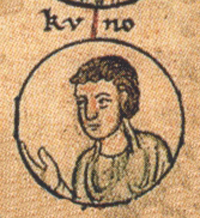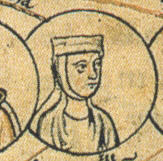Related Research Articles

The Ottonian dynasty was a Saxon dynasty of German monarchs (919–1024), named after three of its kings and Holy Roman Emperors named Otto, especially its first Emperor Otto I. It is also known as the Saxon dynasty after the family's origin in the German stem duchy of Saxony. The family itself is also sometimes known as the Liudolfings, after its earliest known member Count Liudolf and one of its primary leading-names. The Ottonian rulers were successors of the Germanic king Conrad I who was the only Germanic king to rule in East Francia after the Carolingian dynasty and before this dynasty.

The Salian dynasty or Salic dynasty was a dynasty in the High Middle Ages. The dynasty provided four kings of Germany (1024–1125), all of whom went on to be crowned Holy Roman emperors (1027–1125).

Conrad II, also known as Conrad the Elder and Conrad the Salic, was Emperor of the Holy Roman Empire from 1027 until his death in 1039. The first of a succession of four Salian emperors, who reigned for one century until 1125, Conrad also served as King of Germany from 1024, King of Italy from 1026, and King of Burgundy (Arelat) from 1033.

The Duchy of Carinthia was a duchy located in southern Austria and parts of northern Slovenia. It was separated from the Duchy of Bavaria in 976, and was the first newly created Imperial State after the original German stem duchies.
Conrad, called the Red, was Duke of Lorraine from 944 until 953. He became the progenitor of the Imperial Salian dynasty.

Henry of Speyer, a member of the Salian dynasty, was count in the Rhenish Franconian Wormsgau. He was the father of Emperor Conrad II.
Hermann III was a member of the Conradine dynasty. He was Duke of Swabia from 1003 until 1012.

Otto I, called Otto of Worms, a member of the Salian dynasty, was Duke of Carinthia from 978 to 985 and again from 1002 until his death.
Adalbero of Eppenstein was Duke of Carinthia and Margrave of Verona from 1011 or 1012 until 1035.

Conrad I, a member of the Salian dynasty, was Duke of Carinthia from 1004 until his death.
Conrad II, called the Younger, a member of the Salian dynasty, was Duke of Carinthia and Margrave of Verona from 1035 until his death.

The Duchy of Franconia was one of the five stem duchies of East Francia and the medieval Kingdom of Germany emerging in the early 10th century. The word Franconia, first used in a Latin charter of 1053, was applied like the words Francia, France, and Franken, to a portion of the land occupied by the Franks.

Liutgarde of Saxony, a member of the Ottonian dynasty, was Duchess consort of Lorraine from 947 until her death by her marriage with Duke Conrad the Red. She and Conrad became progenitors of the Salian dynasty.

Henry I was King of the Franks from 1031 to 1060. The royal demesne of France reached its smallest size during his reign, and for this reason he is often seen as emblematic of the weakness of the early Capetians. This is not entirely agreed upon, however, as other historians regard him as a strong but realistic king, who was forced to conduct a policy mindful of the limitations of the French monarchy.

Henry III, called the Black or the Pious, was Holy Roman Emperor from 1046 until his death in 1056. A member of the Salian Dynasty, he was the eldest son of Emperor Conrad II of Germany and Gisela of Swabia.

Matilda of Swabia, a member of the Conradine dynasty, was Duchess of Carinthia by her first marriage with Duke Conrad I and Duchess of Upper Lorraine by her second marriage to Duke Frederick II. She played an active role in promoting her son, Duke Conrad the Younger, as a candidate for the German throne in 1024 and to this end corresponded with King Mieszko II of Poland.

The Mark an der Sann was a border march of the Holy Roman Empire, in the territory of present-day Slovenia. It was established in the second half of the 10th century to protect the Empire against its enemies to the east, especially from Hungarian raids.
Egilbert was bishop of Freising in Germany from 1005 to 1035. He was the tutor of Henry, Duke of Bavaria—the future Henry III, Holy Roman Emperor—between 1029 and 1033.
References
- ↑ Wolfram 2006, p. 18.
- ↑ Weinfurter 1999, p. 184.
- ↑ Weinfurter 1999, pp. 11, 190 (note 10).
- ↑ Wolfram 2006, p. 323.
- ↑ Weinfurter 1999, p. 190 (note 1).
- ↑ Wolfram 2006, p. 272.
- 1 2 3 4 Wolfram 2006, p. 271.